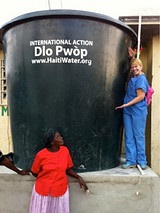West Department Clean Water Project
 The West Department Clean Water Project Impact: Roughly 780,000 Haitians now have permanent access to clean water because of our efforts with the West Department Clean Water Project
The West Department Clean Water Project Impact: Roughly 780,000 Haitians now have permanent access to clean water because of our efforts with the West Department Clean Water Project
This has been our flagship project since 2005. The goal of the program is to provide clean, safe water to all communities in the West Department of Haiti, which includes Port-au-Prince. The capital city is home to nearly 2.5 million people and almost no one has access to running water. The Government of Haiti provides neighborhoods with water kiosks, but the water at many of these stations remains untreated. At kiosks that do not have water treatment system, International Action intervenes. With the help of local water committees and Haitian officials, we provide clean, safe water to hundreds of communities in the West Department by installing chlorinators on neighborhood water kiosks.
Chlorinator Installation
To date, we’ve installed and maintain roughly 125 chlorinators in the West Department – with a total of 262 chlorinators installed throughout Haiti . For as little as $300 per chlorinator, a community of up to 10,000 can receive drinkable water. Learn more
Water Tanks Installation
The earthquake of 2010 damaged or destroyed many of the community water tanks around Haiti. In an effort to help rebuild, we have repaired all our large volume water tanks and continue to install large volume 2,000-gallon water tanks in communities. These tanks allow thousands of Haitians to access clean water. Additionally, 150-gallon tanks have been installed at nearly all of the 92 schools in Cité Soleil, ensuring Haitian children don’t go thirsty. Learn more
Chlorine Distribution
Our warehouse in Haiti stores chlorine tablets, granular chlorine, and chlorine testing kits ready for distribution to communities in need. Our chlorine solutions are safe, easy-to-use options for providing clean water in Haiti. Learn more
Clean Water for Schools Project
The West Department is also the area where we targetted our previous Clean Water for Schools Project. Now, many of these schools are self-sustaining but we continue to donate to those who still require chlorine tablets to run their chlorinators.
